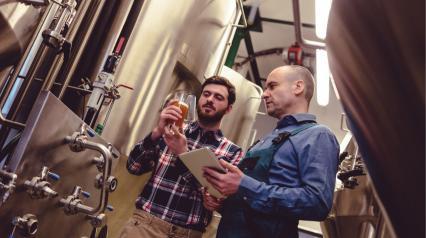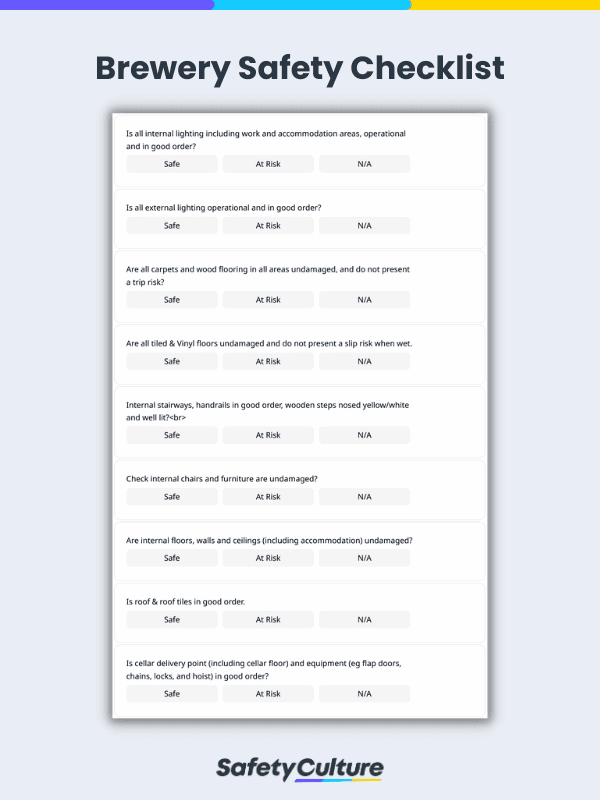What is a Brewery Safety Checklist?
A brewery safety checklist is a tool used by owners or operators, and their personnel to reinforce safety precautions in beer-making facilities. Brewery safety checklists often emphasize on inspecting crucial safety checkpoints such as working spaces, equipment, and cleaning or housekeeping. Using a mobile-ready brewery safety checklist can help immediately detect, reduce, and prevent common brewery hazards with ease.
What is Brewery Safety?
Brewery safety is the practice of ensuring a safe work environment for workers and visitors in the beer-making industry. Safety risks involved in brewery operations can lead to costly lost-time injuries and penalties from authorities. Implementing brewery safety programs not only improves health and safety conditions but also helps brewing business owners meet industry standards.
What are the Top 5 Hazards in the Brewery Industry?
According to OSHA, common violations range from ergonomic injuries to confined spaces, PPE, lockout/tagout, and forklift usage. Here are the 5 most common hazards related to brewery operations:
- Ergonomics – In breweries, the most common challenges to healthy ergonomics are repetitive motions; lifting heavy or awkward objects; and awkward postures caused by leaning, reaching, or bending.
- Slips, trips, and falls – These are quite common in breweries and are heightened by physical hazards such as wet or slippery floors, elevated platforms, improperly stacked items, and more. They affect not only workers but the public as well, such as customers, tour-goers, and outside contractors.
- Confined spaces – According to OSHA, working in confined spaces has some of the most violated practices in the brewing industry, which in turn has resulted in numerous cases of serious injuries or illnesses. State and federal OSHA regulations require breweries to comply with safe practices when working in confined spaces to ensure the safety of both workers and visitors.
- Powered industrial trucks – Brewery operations often require the use of forklifts, pallet trucks, and other types of powered trucks to transport raw materials, move and reach equipment, and lift heavy items. While they prove to be essential, their operation also comes with hazards if not properly operated and maintained.
- Handling of packed gases and chemicals – A major component in brewing are packed gases and caustic chemicals. If not properly handled, these supplies can expose breweries to risks of fire and explosion and endanger the health of both workers and visitors.
What are the Safety Precautions for Common Brewery Hazards?
Listed below are some safety precautions owners and operators can take to address the top 5 hazards in the beer-making industry:
Brewery Ergonomics
- Train workers with the proper lifting technique.
- Automate processes that involve lifting (e.g. use of hoists, conveyors, keg robots).
- Use tools like standing mats, joint braces, or back braces to help support workers.
Preventing Slips, Trips, and Falls in the Brewery
- Installment of railings to mitigate accidents when walking on stairways or elevated surfaces.
- Placement of cones on wet floors.
- Placement of placards and signs to alert people or prohibit from potentially hazardous areas of the brewery.
- Painting lines on the floor to indicate where visitors are allowed and where they are not.
- Encouraging brewery staff to wear proper PPE and non-slip shoes.
Working in Brewery Confined Spaces
- Understand the legal requirements for confined space safety and delegate a qualified person to access the facility and identify all known confined spaces.
- OSHA requires a written Confined Space Permit Program which identifies and evaluates hazards that may be present. This involves testing atmospheric conditions of a confined space, and instructions for summoning rescue and emergency services.
- Enforce employees to have a confined space entry permit before performing work in a confined space. Entry permits should be signed by the respective supervisor.
- Provide employees with the necessary training for working in a confined space.
Operating Powered Industrial Trucks in the Brewery
- Provide forklift operators with the appropriate training from a competent trainer.
- Perform daily forklift and powered trucks inspections.
Handling Brewery Packed Gas and Chemicals
- Clearly label chemicals, especially those that are hazardous.
- Ensure chemicals are stored in a secured area with proper ventilation and posted warning signs.
- Stay on top of maintenance and cleanliness of cylinders and monitor gas pressure routinely.
- Use a lockout/tagout system to clearly mark tanks that are shut down for service.
- Use PPE (clothing, rubber gloves, goggles, and face shields) as recommended by safe work procedures.
What to Include in a Brewery Safety Checklist?
Below are components of a health and safety program that breweries can refer to when building their own health and safety program and brewery safety checklist:
Managing Brewery Health and Safety Risks
To be able to manage health and safety risks in breweries, you must be able to identify first what these risks are. Managing health and safety risks involves identifying hazards, assessing the risks, and controlling those risks.
Safe Beer-making Procedures
Safe work procedures are written step-by-step descriptions of performing a task safely. Below are examples of tasks in breweries that require a written safe work procedure:
- Cleaning and sanitizing a tank
- Boiling the wort in a brew kettle
- Cleaning and sanitizing a bottling, canning, or packing line
- Starting and troubleshooting a boiler
- Operating a forklift or mobile equipment
- Entering a tank
- Filling a keg
Orientation, Education, Training, and Supervision
Employers should provide workers with the appropriate training and ensure that they receive proper orientation before starting work. Written safe work procedures or safe work method statements can be used for training.
Brewery Facility Inspections
Performing workplace inspections can help breweries manage hazards and risks in their space. Inspections should be done at least once a month to prevent unsafe working conditions from developing.
Incident Investigation
In cases where an accident or incident occurs in breweries, incident investigations are performed to determine the cause and next steps to take to prevent a recurrence. They should be well-documented to help support insurance claim investigations.
Brewery Health and Safety Meetings
Safety meetings should be regularly done and should be recorded. During safety meetings, bring and discuss the following:
- Latest inspection report
- Record of incidents reports completed during the past month
- New safe work procedures
- Last month’s meeting
First Aid and Emergency Response
Employees should ensure that a first aid kit and first aid attendant are present on site. An emergency response protocol should also be in place.
Brewery Records and Statistics
Employers are required to keep health and safety records on file. Keeping and maintaining documentation of health and safety records can help the business identify trends in unsafe conditions or work practices and use them as material for employee training. Examples of health and safety records you should keep are the following:
- Risk assessment or hazard analysis reports
- Inspection reports
- Monthly meeting records
- Incident investigation reports
- First-aid records
- Confined space entry permits
- Equipment maintenance records



